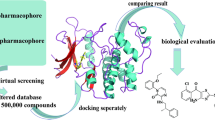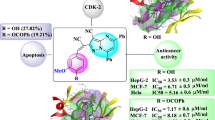Abstract
Cell division cycle 7 (CDC7) is a serine/threonine kinase, which plays a vital role in the replication initiation of DNA synthesis. Overexpression of the CDC7 in various tumor growths and in cell proliferation makes it a promising target for treatment of cancers. To investigate the binding between the CDC7 and furanone inhibitors, and in order to design highly potent inhibitors, a three-dimensional quantitative structure activity relationship (3D-QSAR) with molecular docking was performed. The optimum CoMSIA model showed significant statistical quality on all validation methods with a determination coefficient (R2 = 0.945), bootstrapping R2 mean (BS-R2 = 0.960), and leave-one-out cross-validation (Q2) coefficient of 0.545. The predictability of this model was evaluated by external validation using a test set of nine compounds with a predicted determination coefficient R2test of 0.96, besides the mean absolute error (MAE) of the test set was 0.258 log units. The extracted contour maps were used to identify the important regions, where the modification was necessary to design a new molecule with improved activity. Furthermore, a good consistency between the molecular docking and contour maps strongly demonstrates that the molecular modeling is reliable. Based on those obtained results, we designed several new potent CDC7 inhibitors, and their inhibitory activities were validated by the molecular models. Additionally, those newly designed inhibitors showed promising results in the preliminary in silico ADMET evaluations.





Similar content being viewed by others
References
Labib K (2010) Howdo Cdc7 and cyclin-dependent kinases trigger the initiation of chromosome replication in eukaryotic cells? Genes Dev 24:1208–1219. https://doi.org/10.1101/gad.1933010
Masai H, Arai K-I (2002) Cdc7 kinase complex: a key regulator in the initiation of DNA replication. J Cell Physiol 190:287–296. https://doi.org/10.1002/jcp.10070
Hayano M, Kanoh Y, Matsumoto S, Masai H (2011) Mrc1 marks early-firing origins and coordinates timing and efficiency of initiation in fission yeast. Mol Cell Biol 31:2380–2391. https://doi.org/10.1128/MCB.01239-10
Matsumoto S, Masai H (2013) Regulation of chromosome dynamics by Hsk1/Cdc7 kinase. Biochem Soc Trans 41:1712–1719. https://doi.org/10.1042/BST20130217
Montagnoli A, Moll J, Colotta F (2010) Targeting cell division cycle 7 kinase: a new approach for cancer therapy. Clin Cancer Res 16:4503–4508. https://doi.org/10.1158/1078-0432.CCR-10-0185
Kulkarni AA, Kingsbury SR, Tudzarova S et al (2009) Cdc7 kinase is a predictor of survival and a novel therapeutic target in epithelial ovarian carcinoma. Clin Cancer Res 15:2417–2425. https://doi.org/10.1158/1078-0432.CCR-08-1276
Choschzick M, Lebeau A, Marx AH et al (2010) Overexpression of cell division cycle 7 homolog is associated with gene amplification frequency in breast cancer. Hum Pathol 41:358–365. https://doi.org/10.1016/j.humpath.2009.08.008
Huggett MT, Tudzarova S, Proctor I et al (2016) Cdc7 is a potent anti-cancer target in pancreatic cancer due to abrogation of the DNA origin activation checkpoint. Oncotarget 7:18495–18507. https://doi.org/10.18632/oncotarget.7611
Kim JM, Kakusho N, Yamada M et al (2008) Cdc7 kinase mediates Claspin phosphorylation in DNA replication checkpoint. Oncogene 27:3475–3482. https://doi.org/10.1038/sj.onc.1210994
Feng D, Tu Z, Wu W, Liang C (2003) Inhibiting the expression of DNA replication-initiation proteins induces apoptosis in human cancer cells. Cancer Res 63:7356–7364
Swords R, Mahalingam D, O’Dwyer M et al (2010) Cdc7 kinase – a new target for drug development. Eur J Cancer 46:33–40. https://doi.org/10.1016/j.ejca.2009.09.020
Kurasawa O, Oguro Y, Miyazaki T et al (2017) Identification of a new class of potent Cdc7 inhibitors designed by putative pharmacophore model: synthesis and biological evaluation of 2,3-dihydrothieno[3,2- d ]pyrimidin-4(1 H )-ones. Bioorg Med Chem 25:2133–2147. https://doi.org/10.1016/j.bmc.2017.02.021
Irie T, Asami T, Sawa A et al (2017) Discovery of novel furanone derivatives as potent Cdc7 kinase inhibitors. Eur J Med Chem 130:406–418. https://doi.org/10.1016/j.ejmech.2017.02.030
Roy K, Kar S, Das RN (2015) Understanding the basics of QSAR for applications in pharmaceutical sciences and risk assessment. Underst Basics QSAR Appl Pharm Sci Risk Assess. https://doi.org/10.1016/C2014-0-00286-9
Dearden JC (2016) The history and development of quantitative structure-activity relationships (QSARs). Int J Quant Struct Relat 1:1–44. https://doi.org/10.4018/IJQSPR.2016010101
Klebe G, Abraham U, Mietzner T (1994) Molecular similarity indices in a comparative analysis (CoMSIA) of drug molecules to correlate and predict their biological activity. J Med Chem 37:4130–4146. https://doi.org/10.1021/jm00050a010
Damale MG, Harke SN, Kalam Khan FA et al (2014) Recent advances in multidimensional QSAR (4D-6D): a critical review. Mini Rev Med Chem 14:35–55
Holder S, Lilly M, Brown ML (2007) Comparative molecular field analysis of flavonoid inhibitors of the PIM-1 kinase. Bioorg Med Chem 15:6463–6473. https://doi.org/10.1016/j.bmc.2007.06.025
Huang X, Liu T, Gu J et al (2001) 3D-QSAR model of flavonoids binding at benzodiazepine site in GABA a receptors. J Med Chem 44:1883–1891. https://doi.org/10.1021/jm000557p
Veras L da S, Arakawa M, Funatsu K, Takahata Y (2010) 2D and 3D QSAR studies of the receptor binding affinity of progestins. J Braz Chem Soc 21:872–881. https://doi.org/10.1590/S0103-50532010000500015
Clark M, Cramer RD, Van Opdenbosch N (1989) Validation of the general purpose tripos 5.2 force field. J Comput Chem 10:982–1012. https://doi.org/10.1002/jcc.540100804
Purcell WP, Singer JA (1967) A brief review and table of semiempirical parameters used in the Hueckel molecular orbital method. J Chem Eng Data 12:235–246. https://doi.org/10.1021/je60033a020
AbdulHameed MDM, Hamza A, Liu J, Zhan C-G (2008) Combined 3D-QSAR modeling and molecular docking study on Indolinone derivatives as inhibitors of 3-phosphoinositide-dependent protein Kinase-1. J Chem Inf Model 48:1760–1772. https://doi.org/10.1021/ci800147v
Zheng J, Xiao G, Guo J et al (2011) Exploring QSARs for 5-lipoxygenase (5-LO) inhibitory activity of 2-substituted 5-Hydroxyindole-3-carboxylates by CoMFA and CoMSIA. Chem Biol Drug Des 78:314–321. https://doi.org/10.1111/j.1747-0285.2011.01146.x
Wold S (1991) Validation of QSAR’s. Quant Struct Relat 10:191–193. https://doi.org/10.1002/qsar.19910100302
Kubinyi H (2003) Comparative molecular field analysis (CoMFA). Handb Chemoinform 1555–1574. https://doi.org/10.1002/9783527618279.ch44d
Cruciani G, Baroni M, Clementi S et al (1992) Predictive ability of regression models. Part I: standard deviation of prediction errors (SDEP). J Chemom 6:335–346. https://doi.org/10.1002/cem.1180060604
Baroni M, Clementi S, Cruciani G, Costantino G, Riganelli D, Oberrauch E (1992) Predictive ability of regression models. Part II: Selection of the best predictive PLS model. J Chemom 6:347–356
Golbraikh A, Tropsha A (2002) Beware of q2! J Mol Graph Model 20:269–276. https://doi.org/10.1016/S1093-3263(01)00123-1
Roy K, Das RN, Ambure P, Aher RB (2016) Be aware of error measures. Further studies on validation of predictive QSAR models. Chemom Intell Lab Syst. https://doi.org/10.1016/j.chemolab.2016.01.008
Rücker C, Rücker G, Meringer M (2007) Y-randomization and its variants in QSPR/QSAR. J Chem Inf Model 47:2345–2357. https://doi.org/10.1021/ci700157b
Tropsha A, Gramatica P, Gombar VK (2003) The importance of being earnest: validation is the absolute essential for successful application and interpretation of QSPR models. QSAR Comb Sci 22:69–77. https://doi.org/10.1002/qsar.200390007
Jain AN (2007) Surflex-dock 2.1: robust performance from ligand energetic modeling, ring flexibility, and knowledge-based search. J Comput Aided Mol Des 21:281–306. https://doi.org/10.1007/s10822-007-9114-2
Jain AN (2003) Surflex: fully automatic flexible molecular docking using a molecular similarity-based search engine. J Med Chem 46:499–511. https://doi.org/10.1021/jm020406h
Wang J, Kollman PA, Kuntz ID (1999) Flexible ligand docking: a multistep strategy approach. Proteins 36:1–19
Trott O, Olson AJ (2010) AutoDock Vina: improving the speed and accuracy of docking with a new scoring function, efficient optimization, and multithreading. J Comput Chem 31:455–461. https://doi.org/10.1002/jcc.21334
(2016) Dassault Systèmes BIOVIA, Discovery Studio Modeling Environment, Release 2017, San Diego: Dassault Systèmes. http://accelrys.com/products/collaborative-science/biovia-discovery-studio/. Accessed 25 Feb 2017
Gupta P, Garg P, Roy N (2012) Identification of novel HIV-1 integrase inhibitors using shape-based screening, QSAR, and docking approach. Chem Biol Drug Des 79:835–849. https://doi.org/10.1111/j.1747-0285.2012.01326.x
Daina A, Michielin O, Zoete V (2017) SwissADME: a free web tool to evaluate pharmacokinetics, drug-likeness and medicinal chemistry friendliness of small molecules. Sci Rep 7:42717. https://doi.org/10.1038/srep42717
Hickey JP, Passino-reader DR (1991) Linear solvation energy Relationships : “ rules of thumb ” for estimation of variable values. 25:1753–1760
Lipinski CA (2004) Lead- and drug-like compounds: the rule-of-five revolution. Drug Discov Today Technol 1:337–341. https://doi.org/10.1016/j.ddtec.2004.11.007
Pires DE V, Blundell TL, Ascher DB pkCSM: Predicting Small-Molecule Pharmacokinetic and Toxicity Properties Using Graph-Based Signatures. https://doi.org/10.1021/acs.jmedchem.5b00104
Acknowledgments
We are grateful to the “Association Marocaine des Chimistes Théoriciens” (AMCT) and “Moroccan Centre of Scientific and Technique research” (CNRST) for their pertinent help concerning the programs.
Author information
Authors and Affiliations
Corresponding author
Ethics declarations
Conflict of interests
The authors declare that they have no conflict of interest.
Ethical approval
This chapter does not contain any studies with human participants or animals performed by any of the authors.”
Rights and permissions
About this article
Cite this article
Aouidate, A., Ghaleb, A., Ghamali, M. et al. Furanone derivatives as new inhibitors of CDC7 kinase: development of structure activity relationship model using 3D QSAR, molecular docking, and in silico ADMET. Struct Chem 29, 1031–1043 (2018). https://doi.org/10.1007/s11224-018-1086-4
Received:
Accepted:
Published:
Issue Date:
DOI: https://doi.org/10.1007/s11224-018-1086-4




